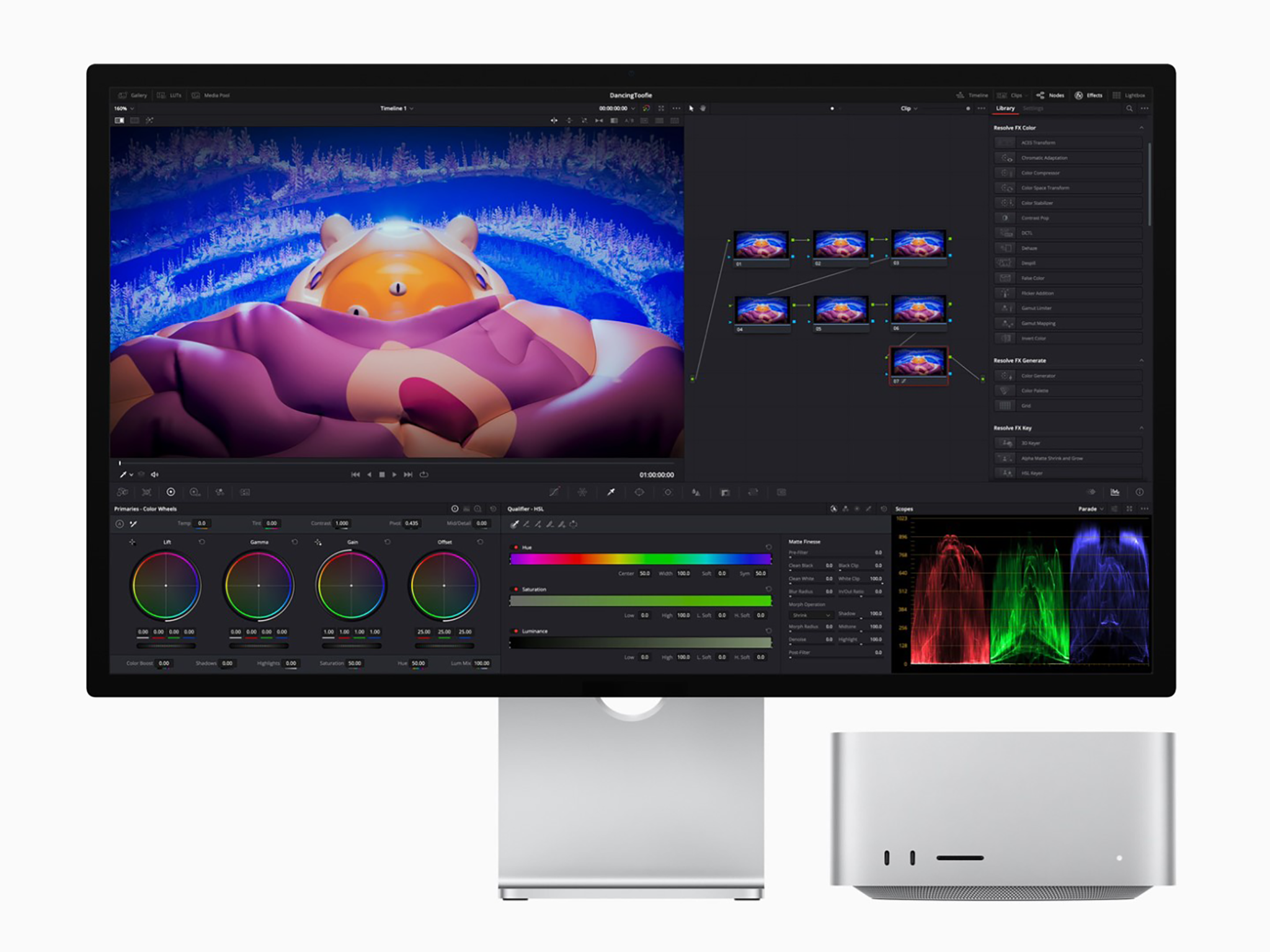Apple Mac studio

- Processor: Apple M2 max or M2 ultra chip
- Memory chip: 32GB, 64GB, 96GB, 128GB or 192GB, depending on model
- Storage: 512GB - 8TB
- Dimensions: 9.5cm x 19.7cm x 19.7cm
- Weight: 2.7 kg (max) or 3.6kg (ultra)
- Colours: Silver
Apple Mac studio design
The external design of the new Mac studio is identical to the one from last year. As such, it retains the commitment to function over form which was a marked change when it arrived in 2022.
Last year, we said that the computer was something of a tank. It is a big metal box with plenty of space for cooling and many ports for connections. That remains true. It is far from the most beautiful computer in the world – with the exception of the circle of holes on the bottom that allow the fans to work, there is not a single notable part of the design at all – but it doesn’t seem to want to be. Other Apple computers are sleek workhorses, whereas this is a proud Ford Bronco: a big, mostly square box full of grunt.
Apple is clearly satisfied with the practical nature of the computer, and users seem to be too. Unlike other Apple computers that sacrifice utility for beauty, the Mac studio gives you everything you need, even when it’s a little brutal, like the large holes cut in the front for its ports. It’s a computer built for doing, rather than seeing – and it does everything very well indeed.
Read more: Apple’s MacBook air 15in is bigger, but is it better?
There is however one important change to last year’s version. The Mac studio that we reviewed last year had a slightly audible whirr, which was not annoying but equally not entirely ignorable. Reports after the release indicated that our unit was not alone – although not every Mac studio was affected.
This year’s Mac studio appears to have avoided this problem, at least in our case. The fans have been altered slightly to make them less audible, and the unit that Apple sent this time around is practically silent.
Apple Mac studio performance
The new update, then, is entirely based on the inside. And beyond some tweaks such as the fan, the main change is to add Apple’s new M2 max and M2 ultra chips to the line-up, replacing the M1 max and M1 ultra.
When the Mac studio was released last year it became something of a standard bearer for the professional performance of Apple silicon. Those chips were astonishingly fast, making the most of Apple’s history in creating efficient but powerful processors for its iPhone and upgrading them to Mac size. That Apple silicon first arrived in the form of Apple’s M1 at the end of 2020. Since then, Apple has upgraded to new generations (the M2) and more speed-focused versions (the pro, max and ultra); the Mac studio follows the recent MacBook pro in combining those improvements together with the M2 max, and is the first outing for the M2 ultra, which is two M2 max chips stuck together.
The performance of Apple’s recent computers has become such that it is quite difficult to push them to their limits, and the tests can feel a little silly. Apple says that the version of the Mac studio with the M2 ultra chip can play 22 streams of 8K prores video at once, for instance; something that may be specifically useful to a small number of people but is more telling as a demonstration of just how much these computers can have thrown at them.
Read more: The best laptop deals in the UK this month
Those tests might be silly, but they are important. And so the last couple of days, we have been pushing the Mac studio to its very limits and struggling to find them. We opened Apple’s logic pro and loaded up Spitfire Audio’s sumptuous library of sounds from the BBC Symphony Orchestra, for instance, and dropped in as many instruments as we possibly could. The computer kept going, absorbing what became a cacophony of 100 tracks of software instruments without a complaint.
We did the same with a variety of other projects: huge 3D models, opening up an array of 4K videos on the screen at once. We did all these things together – orchestra and the 3D world created in the Unreal Engine both open at the same time, for instance – and the Mac studio still carried on quietly. One of the particularly tough things about the performance of recent Apple computers is that it makes it very difficult to evaluate.
As previously mentioned, these are the results of only a couple of days with the computer, and there will be more to come. (With a bit more time we intend to make that orchestra even louder and more chaotic.) This review will be updated when the Mac studio can be put through its paces even more with professional software used in audio, video and more.
Read more: Apple MacBook pro M2 16in review
In practice through those first couple of days, though, the computer felt noticeably but not overwhelmingly faster than its (already very fast) predecessor in last year’s Mac studio. It felt as if it could handle a little more, a little more quickly – a bump that you could call modest were it not for the fact that the performance is so very brazen.
These improvements are roughly in line with Apple’s claimed improvements for the new chips. It says that the Mac studio with M2 max is able to render motion graphics up to 50 per cent faster in After Effects, and build apps up to 25 per cent faster in Xcode; the M1 ultra can render 3D artwork three times more quickly, and colourists can process video up to 50 per cent faster in DaVinci Resolve.
Those are of course the more flattering of the numbers, and the general performance suggests that the Mac studio is roughly 20 per cent faster than its equivalent model last year. (That is borne out by benchmarks such as Geekbench, which show an improvement of roughly a fifth and indicate that the ultra is now the fastest chip Apple has ever made.) But that fifth is not to be sniffed at: it is a noticeable improvement from an already very high base.
Apple is making something of a new push into gaming and announced a variety of updates during its event this week. Those included new tools to let developers more easily put their existing games onto the Mac, and a new “Game Mode” in the upcoming MacOS that lets them take priority for access to processing power and should make them run more quickly.
Read more: iPhone 15 rumours, from release dates to prices and specs
But those ported games are not here yet, and neither is MacOS Sonoma and its Game Mode. In limited testing with some existing titles, the Mac studio handled itself very well – but that’s to be expected, especially when there are few truly challenging titles available for the platform. We will update this review at a later date when the Mac studio can be challenged on gaming a little more.
In addition to the new powerful chip, Apple has also added a range of connectivity upgrades. The computers now have Bluetooth 5.3, WiFi 6E, support 8K displays and can run up to six of Apple’s pro Display XDRs.
In all, the performance upgrade is meaningful, adding new power to an already astonishingly powerful machine. While the improvement is not really comparable to the speed increase achieved when Apple switched to its own chips, we might never see that again – and it is a sign of how spoiled we are by these computers that an improvement of 25 per cent in the time it takes to build an app feels relatively modest.
Mac studio vs Mac pro
Apple announced this year’s Mac studio alongside a more surprising update, in the form of a new Mac pro. As the name suggests, the Mac pro is Apple’s highest-priced and most professionally focused computer – it got a flagship update in 2019 and has barely been touched since. It was so neglected that some feared it might have been killed off, with the studio taking its place. Then, at Apple’s announcement event, a new Mac pro appeared, alongside the Mac studio that might have killed it off.
Still, it was a little strange, feeling like the most minimal update that it could have received, and its main function seemed to be to finally complete Apple’s transition from Intel chips to its own processors. The outside was the exact same design as that 2019 computer. On the inside, it received the M2 ultra chip – powerful, yes, but with no more power than when you get it in the new Mac studio, despite all the extra space in the computer.
Instead, that extra space is intended for expansion through PCIe slots, which can take cards that can boost the audio, video or storage performance of the computer, though not the graphics performance that would have been the most obvious use for such expansion. That is the only difference now from the Mac studio with the M2 ultra processor, which might suggest that those who believe that the studio was really intended as a replacement for the pro were right.
Read more: Everything we know about the Apple VR headset
In practice, it means that almost everyone who needs the Mac pro is now better off buying the higher-end Mac studio: it is much cheaper and smaller, as well as being a more modern design. If you are in that small group of people who are likely to need those expansion slots, then you probably already know that the Mac pro is your choice; if not, as will be the case for almost everyone, the Mac pro is best avoided.
It remains to be seen whether this will be the case over time. When Apple first released its own chips, it put them into existing designs that left people clamouring for more; there might be a bigger and better redesign of the Mac pro coming in the future that could make a more robust case for why it exists. Or Apple might opt to do away with it entirely.












